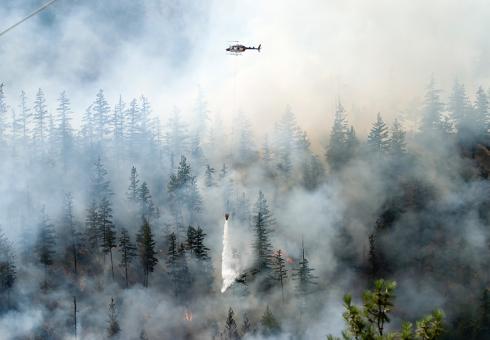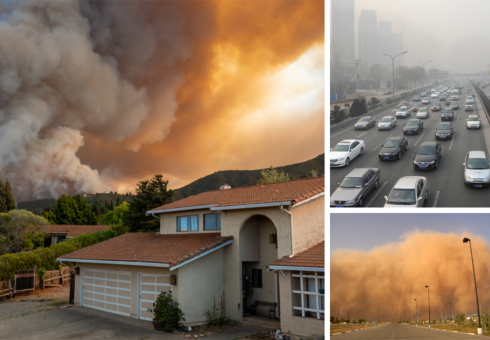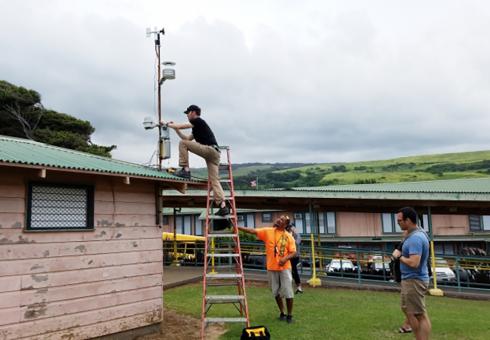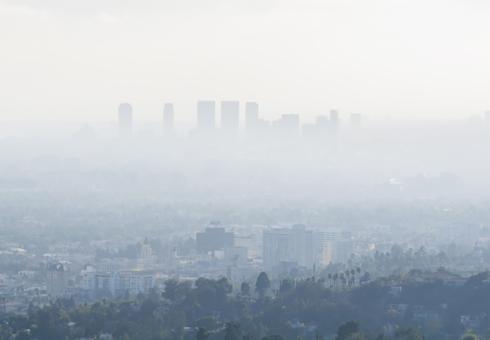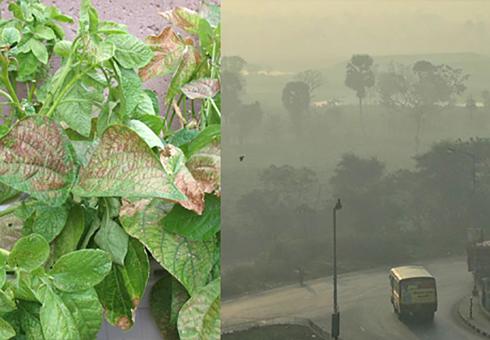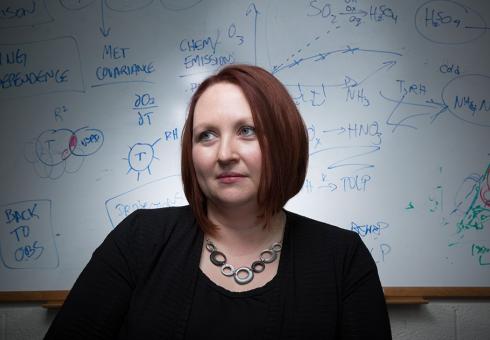As Canada’s wildfires continue to be felt downwind, MIT experts weigh in on what to expect in the coming months, with wildfire season underway
News and Outreach: Colette L. Heald
MIT research highlights the opportunity to rethink global air quality guidelines
Six campus events to focus on the urgent challenges of climate change and climate action
Low-cost sensors on Hawaii's Kilauea volcano provide an educational resource and give insight into air quality across Big Island
Joint Program-affiliated researchers share findings at nexus of food, agriculture, environment and health
Research shows the Clean Air Act was likely responsible for a dramatic decline in atmospheric organic aerosol
Colorado forest study provides clearest-ever picture of gases released into the atmosphere and how they change
MIT Joint Program-affiliated researcher Collette Heald is leading an effort to better understand the relationship between air pollution and agriculture
'This is not a view shared by us': After MIT professor emeritus Richard Lindzen writes letter urging Trump to withdraw from climate accord, faculty responds.
Related coverage: Climate@MIT, Boston Globe
Colette Heald studies atmospheric gases and particles, and how they affect air quality and climate
Winds that blow across the Sahara desert in North Africa pick up particles of soil and sand, and typically carry them westward. Many of these grains travel across the Atlantic, leading to poor-visibility days in the southern U.S. and Caribbean, transporting nutrients to far-flung ecosystems in South America, and impacting hurricane formation in the Atlantic.
That’s just one example of the myriad ways that the behavior of tiny particles blown by the wind can have large-scale local, regional, and even global effects on the complex systems that govern Earth’s atmosphere. For Colette Heald, trying to unravel the intricate patterns of the atmosphere’s composition and chemistry, and the way these affect ecosystems, air quality, and even the climate itself, has been the driving force of her career.
Heald, who earned tenure at MIT last year, is the Mitsui Career Development Associate Professor in the Department of Civil and Environmental Engineering and also holds an appointment in the Department of Earth, Atmospheric and Planetary Sciences. Originally from Canada, she was born in Montreal and grew up in Ottawa, where her father was a paper industry executive and her mother a nurse. An older sister, who still lives in Canada, is an aerospace engineer.
Heald earned her BS in engineering physics at Queen’s University in Kingston, Ontario, and while there started doing summer research projects with faculty members at the University of Toronto. That’s when she got introduced to the field of atmospheric science. “I was so excited,” she says, to discover the deep connections between the kind of technical engineering research she had studied and the global environment. That led her to pursue a doctorate in atmospheric chemistry at Harvard University.
Coming from all directions
“That seemed like a flip from physics,” she recalls, “and I was concerned that I didn’t have the chemistry background for it.” But she soon discovered that the field “is so interdisciplinary; people come from a variety of directions” and bring different perspectives to the research.
She immediately became fascinated by the use of satellite data to study the atmosphere and its interactions. The timing was good: The first satellites measuring atmospheric pollution had been launched just a few years earlier.
One of the things measured by satellites was the concentration of carbon monoxide in the air. That compound “is produced from all kinds of combustion processes, and it’s a nice indicator because it stays in the atmosphere for about a month,” she says, “so we can use it to investigate the transport of plumes from sources to continents down-wind.”
Heald describes her current work as “trying to understand the sources, transformation, and impact of gases and particles in the atmosphere, which is very dynamic with a lot of chemical compounds that interact.” In a sense, she says, her focus is on figuring out what’s missing — where the holes are in models of the atmosphere, and how to fill those gaps. “I take an endpoint perspective,” she says. “I integrate the knowledge we have, and look for new ways to analyze the data to see what’s missing in our models.”
The effects are often subtle and hard to tease out from the chaotic mix of atmospheric processes. For example, in summer months the plumes of dust that constantly waft away from the Sahara desert end up in the North Atlantic and can make landfall in the United States and contribute to poor air quality in Florida. In the winter months winds blow the dust, which bears a complex load of assorted minerals, across to South America.
Trans-Atlantic fertilizer
One of those minerals is phosphorus, which happens to be a key limiting element for the growth of plants in the Amazon basin — so those African breezes are actually contributing to the Amazon’s fertility. That’s the kind of complex interaction, she explains, that would never be derived solely from theoretical modeling or experimental observation but requires the integration of different disciplines and approaches. “That gives you a sense of the challenge,” she says.
“There needs to be a strong coupling between observational work and modeling,” Heald says, “and these are models that take decades of development and a large community of scientists.” Much of her research focuses on aerosols, particles of matter so small that they virtually defy gravity and can stay aloft for weeks. Another major area of her research is the complex interaction between the atmosphere and the biosphere.
One thing that makes the modeling difficult is that many of the important processes in atmospheric chemistry involve transport across ocean basins, and “there are not a lot of observations available” over vast stretches of ocean. For example, for dust “we have long-term records in Barbados and in Florida, but we have to connect the dots” to extrapolate to the missing areas. Satellite data are helping to fill in the blanks, but careful calibration is required to make sure these measurements dovetail with the ground-based records.
Heald’s modeling work has showed, for example, that in recent decades winds have been slowing over Africa, and that could reduce the flow of those aerosols to the Americas. Since those particles have an overall cooling effect, by radiating back incoming sunlight, their reduction leads to an overall warming, she explains.
Heald says she has always been interested in many different subjects and had a hard time initially in college deciding what she wanted to major in, even considering art history. “My sister told me, you’ll always be able to experience art and literature, but it’s hard to pursue science and engineering as a hobby!”
While acknowledging that many women have experienced discrimination in their scientific education and careers, “I feel very fortunate,” Heald says, about the support and encouragement she received throughout her education and early career. “I was never discouraged, always only encouraged. I never felt that any doors were closed to me.”
The community of atmospheric chemists, she says, “is very collegial, and I’m grateful for the smooth path I’ve had and the friendly collaborations I’ve developed along the way. I know not all fields are like that, so when I have a chance to help or give back, I try to get involved.”
Photo: Colette Heald describes her current work as “trying to understand the sources, transformation, and impact of gases and particles in the atmosphere, which is very dynamic with a lot of chemical compounds that interact.” (Photo by Bryce Vickmark)
CBS NEWS || As our need for food rises, our ability to produce that food may be lowered by climate and air quality changes, according a to a study just published in Nature Climate Change.
Eliene Augenbraun
CBS News
The world will need 50 percent more food by 2050 due to both an increasing population and a shift toward a more Westernized diet in developing countries. But as our need for food rises, our ability to produce that food may be lowered by climate and air quality changes, according a to a study just published in Nature Climate Change.
Researchers from MIT and Colorado State University found that if everything else stays as it is today, by 2050 global warming may reduce world crop yields by about 10 percent.
But world crop yields face more challenges than just rising temperatures. Ozone pollution also hurts crops, while being harder to quantify. Some crops are hurt most by extreme temperature swings, others more by ozone.
"Ozone pollution can also be tricky to identify ... because its damage can resemble other plant illnesses, producing flecks on leaves and discoloration," Colette Heald, an author of the study and associate professor of civil and environmental engineering (CEE) at MIT, said in a press release.
While heat and ozone can each damage plants on their own, the two factors also interact. For example, warmer temperatures increase ozone production. The research team calculated that 46 percent of damage to soybean crops on very hot days that had previously been attributed to heat is actually caused by ozone.
The researchers used climate models to map daily temperature variations region by region, comparing the world of 2000 with the world as it is projected to be in 2050. In an email to CBS News, Heald explains, "We developed a statistical model of crop yields based on the historical climate and crop data. We used national crop data from 1960-2000. So effectively our model is based on the observed relationships."
Under some scenarios, the researchers found that pollution-control measures could make a major dent in expected crop reductions. For example, while global food production was projected to fall by 15 percent under one scenario, ozone reduction in an alternate scenario could reduce that drop to 9 percent.
The study looked at four major crops: soybeans, rice, maize, and wheat, which make up half the calories humans consume worldwide. Given its profound effect on many important crops, air pollution will contribute to undernourishment in the developing world. Using the pessimistic air-quality projection, rates of malnourishment in developing countries might increase from the current 18 percent to 27 percent by 2050.
Agricultural production is '"very sensitive to ozone pollution," Heald said in the press release, showing "how important it is to think about the agricultural implications of air-quality regulations. Ozone is something that we understand the causes of, and the steps that need to be taken to improve air quality."
The researchers note in their paper that they did not explore the effect of developing ozone-tolerant crop strains in this study, but "considering the challenge of implementing such a strategy, the questionable efficacy of other crop management practices, as well as the public health co-benefit of ozone control, ozone regulation may prove to be a practical and preferable alternative to help secure global food production." They hope that "farmers, agricultural policy makers, and air quality managers" will work together to promote food security.
The study also did not factor in the effect of rising carbon dioxide (CO2) levels on crop yields. Heald told CBS News, "The focus of our study was looking at the climate and ozone effects on crop yields, both because we thought this was an important contrast to draw, and because these effects are better quantified. The net effect of CO2 on food is less clear -- CO2 fertilizes plants and so we could expect elevated yields under higher CO2, [but] recent work has shown that plants grown under these high CO2 conditions are less nutritious. So one might need to grow more food to meet nutrition demands."
Thomson Reuters || Controlling air pollution could help curb projected declines in global food supplies, a new study says, suggesting policymakers should consider both climate change and ozone pollution in efforts to ensure the world has enough food.
Megan Rowling
Thomson Reuters Foundation
Controlling air pollution could help curb projected declines in global food supplies, a new study says, suggesting policymakers should consider both climate change and ozone pollution in efforts to ensure the world has enough food.
Scientists have largely neglected the interactions between rising temperatures and ozone pollution, which is known to damage crops. But the complex linkages can be significant, said the study, published in the latest issue of the journal Nature Climate Change.
It explored the global production of four food staples - rice, wheat, corn and soy - finding that effects will vary between regions, and some crops are more strongly affected by one of the two factors. Wheat is very sensitive to ozone exposure, while corn is more adversely impacted by heat, for example.
Warmer temperatures can increase ozone production, said researchers at Massachusetts Institute of Technology (MIT), who carried out the study. Ozone is a gas - a form of oxygen - that is explosive and toxic.
Given that farm production is very sensitive to ozone pollution, the study shows "how important it is to think about the agricultural implications of air-quality regulations. Ozone is something that we understand the causes of, and the steps that need to be taken to improve air quality,” said Colette Heald, one of the authors and an MIT associate professor of civil and environmental engineering.
In the United States, for example, tougher air quality regulations will likely lead to a sharp drop in ozone pollution, mitigating its impact on crops. In other regions, the outcome will be shaped by domestic air pollution policies, Heald said. “An air-quality cleanup would improve crop yields,” she added.
The researchers found air pollution will play a part in shaping undernourishment in developing countries. Under a pessimistic air quality scenario, the malnutrition rate may increase from 18 to 27 percent by 2050. Under a more optimistic scenario, it would still go up but the increase would be cut almost in half.
Global warming alone may reduce crop yields globally by about 10 percent by 2050, the study said. But under some scenarios, pollution control measures could offset a proportion of the expected declines.
The damage caused by ozone pollution can be hard to identify, because it resembles other plant illnesses, producing flecks on leaves and discoloration, MIT said.
The researchers found, for example, that 46 percent of damage to soybean crops that had previously been attributed to heat was actually caused by increased ozone.
The projections exclude the complex effect of rising levels of carbon dioxide, a major greenhouse gas that could also help stem falls in global food supplies, they noted.
Denise L. Mauzerall, a professor of environmental engineering at Princeton University who was not involved in the study, described the finding that air pollution controls could improve agricultural yields and partially offset the negative effects of climate change on yields as "important".
"The increased use of clean energy sources that do not emit either greenhouse gases or conventional air pollutants, such as wind and solar energy, would be doubly beneficial to global food security, as they do not contribute to either climate change or increased surface-ozone concentrations,” Mauzerall said in a statement.
(Editing by Ros Russell; rosalind.russell@thomsonreuters.com)

